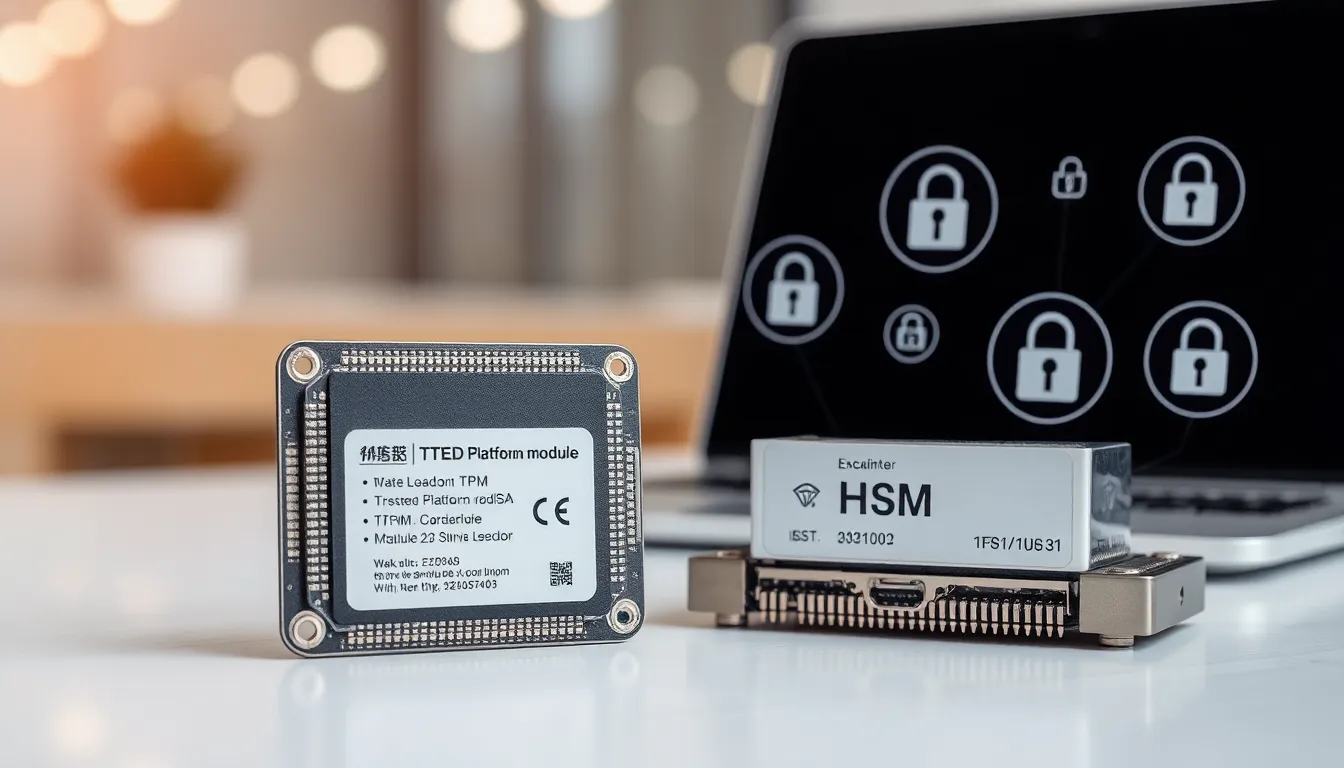Table of Contents
ToggleIn a world where cyber threats lurk around every digital corner, hardware security solutions are the unsung heroes keeping our data safe. Think of them as the bouncers at a high-end nightclub, ensuring only the right guests get in while the troublemakers are left out in the cold. With hackers becoming increasingly crafty, relying on software alone is like bringing a butter knife to a sword fight.
These solutions offer robust protection that goes beyond just software firewalls. They incorporate physical devices that safeguard sensitive information from prying eyes and malicious attacks. So whether it’s a tiny chip in your laptop or a fortress-like security module, investing in hardware security means giving your digital assets the VIP treatment they deserve. After all, who doesn’t want to sleep soundly knowing their data is locked up tighter than a drum?
Overview of Hardware Security Solutions
Hardware security solutions play a critical role in data protection against cyber threats. These solutions integrate various physical devices designed to safeguard sensitive information from unauthorized access. Firewalls and antivirus software serve as software-based defenses, while hardware solutions provide a more comprehensive layer of protection.
Dedicated appliances such as Unified Threat Management (UTM) systems act as all-in-one security solutions. These UTMs combine multiple security features, including firewalls, intrusion detection systems, and content filtering, into a single device. Companies find this approach simplifies management and enhances overall security posture.
Encryption hardware further strengthens data security by ensuring that information remains unreadable during transfer or storage. Hardware Security Modules (HSMs) generate, store, and manage encryption keys, bolstering an organization’s defense against data breaches.
Another essential component involves hardware-based two-factor authentication methods. These methods require physical devices to validate user identity, adding another layer of security. Smart cards and biometric devices have gained popularity for their ability to slot seamlessly into existing security architectures.
Trustworthiness also increases when organizations utilize Trusted Platform Modules (TPMs). These chips are embedded in computers and act as secure repositories for cryptographic keys. Their integration into devices ensures that security features operate on a hardware level, significantly reducing vulnerabilities.
Adopting hardware security solutions leads to numerous benefits. Organizations benefit from reduced risk of data breaches, compliance with regulatory standards, and increased customer trust. Investing in such technology proves essential for those aiming to protect digital assets effectively.
Types of Hardware Security Solutions

Hardware security solutions encompass various technologies aimed at safeguarding sensitive data against cyber threats. Key types include Trusted Platform Modules, Hardware Security Modules, and Secure Boot systems.
Trusted Platform Module (TPM)
Trusted Platform Modules serve as secure cryptoprocessors embedded in devices. These modules provide a dedicated space for cryptographic operations, ensuring the protection of encryption keys. Functions of TPMs include platform integrity verification, which prevents unauthorized software from running during system boot. Additionally, TPMs facilitate digital rights management, offering a secure means to control data access. Their adoption also enhances compliance with security standards, making them critical for organizations aiming to strengthen their cybersecurity posture.
Hardware Security Modules (HSM)
Hardware Security Modules are specialized devices designed for secure encryption key management and cryptographic processing. Organizations utilize HSMs to protect sensitive data both at rest and in transit, greatly reducing the risk of data breaches. HSMs support various cryptographic algorithms, ensuring flexibility for diverse security needs. Their ability to generate and store keys securely adds an extra layer of protection against tampering. Many industries, particularly finance and healthcare, rely on HSMs to comply with regulatory requirements while maintaining customer trust.
Secure Boot and Firmware Protection
Secure Boot and firmware protection mechanisms validate the software integrity during the startup process. They prevent unauthorized code from executing, which could compromise the system. Secure Boot checks digital signatures of boot components, ensuring only trusted software runs. Conversely, firmware protection safeguards the device’s firmware from malicious modifications. This combination of technologies ensures that systems remain secure from boot time through runtime, reinforcing overall hardware security. Organizations implementing these measures significantly reduce their exposure to risks associated with boot-level attacks.
Benefits of Implementing Hardware Security Solutions
Implementing hardware security solutions brings significant advantages for organizations looking to fortify their data security posture.
Enhanced Data Protection
Hardware security solutions provide superior data protection by utilizing physical devices designed to defend against unauthorized access and cyber threats. Such solutions like Hardware Security Modules (HSMs) encrypt sensitive information, ensuring that data remains confidential during storage and transmission. Unified Threat Management systems streamline multiple security features, improving overall protective measures. Organizations benefit from robust encryption capabilities, which obscure data even if malicious actors intercept it. Furthermore, hardware-based authentication methods reduce risks tied to stolen passwords, adding an extra layer of defense. The combination of these features enables organizations to safeguard valuable information effectively.
Resistance to Physical Attacks
Organizations face threats not only from cybercriminals but also from physical attacks. Hardware security solutions effectively mitigate risks associated with unauthorized physical access to sensitive systems. Trusted Platform Modules (TPMs) act as secure cryptoprocessors that protect cryptographic keys from tampering. Secure Boot technologies validate software integrity during startup, defending against boot-level attacks. By ensuring that only trusted code executes during system initialization, hardware solutions form a barrier against potential breaches. This resilience against physical attacks enhances the security of critical assets, making it increasingly difficult for intruders to compromise hardware.
Compliance and Regulatory Standards
Maintaining compliance with regulatory standards is crucial for organizations, especially in sectors like finance and healthcare. Hardware security solutions facilitate adherence to regulations such as GDPR and HIPAA, which mandate stringent data protection measures. Implementing these solutions aids organizations in managing encryption keys securely and processing sensitive data in line with legal requirements. Compliance is often a condition of maintaining customer trust and avoiding costly penalties, making hardware security a strategic investment. Dedicated hardware solutions not only help meet regulatory obligations but also demonstrate a commitment to safeguarding customer information, further reinforcing organizational integrity.
Challenges in Hardware Security Solutions
Hardware security solutions encounter several challenges that organizations must address to maximize their effectiveness.
Cost Considerations
Organizations often face significant costs associated with hardware security solutions. Initial investment in devices can be substantial, affecting budgets. Ongoing maintenance and upgrades require additional financial resources, which may not be available for all businesses. Exploring cost-effective options is crucial for smaller entities, as they may have limited budgets. Many vendors offer tiered pricing models, allowing businesses to select solutions that meet their financial constraints while still providing essential security features. Long-term return on investment often justifies these initial costs, especially when considering the potential financial losses from data breaches.
Integration with Existing Systems
Integrating hardware security solutions with existing systems poses another considerable challenge. Compatibility issues may arise between new devices and legacy systems, complicating deployment. Organizations must assess current infrastructure thoroughly to ensure seamless integration, which often requires professional assistance. Training staff on new hardware can incur delays, impacting overall efficiency. Successfully addressing these integration challenges enhances operational security while maintaining productivity. Ongoing support and updates are essential for ensuring sustained compatibility and security effectiveness across all systems.
Investing in hardware security solutions is vital for organizations aiming to safeguard their sensitive data. By implementing these robust systems, businesses can significantly reduce the risk of cyber threats while ensuring compliance with regulatory standards. The combination of dedicated appliances and advanced technologies like TPMs and HSMs enhances overall security posture.
Though challenges exist in terms of cost and integration, the long-term benefits far outweigh these hurdles. Organizations that prioritize hardware security not only protect their digital assets but also build trust with customers. Ultimately, adopting these solutions is a proactive step toward a secure digital future.







